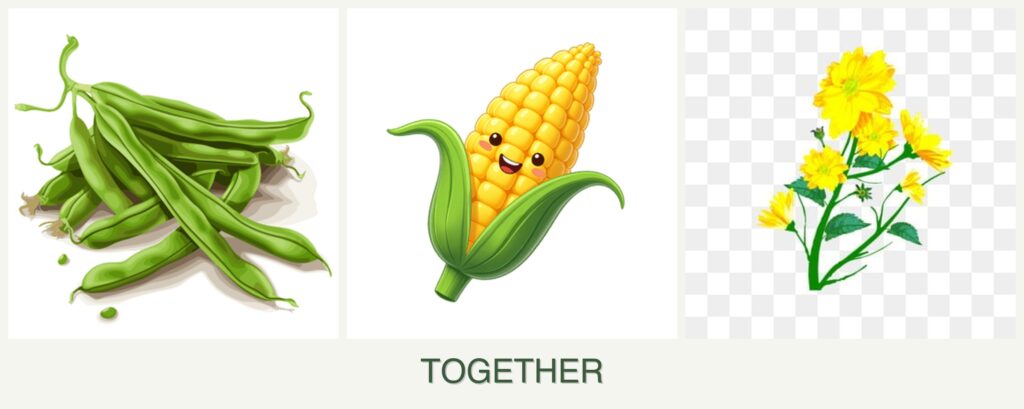
Can you plant beans, corn and calendula together?
Can You Plant Beans, Corn, and Calendula Together?
Companion planting is a popular method among gardeners looking to create a thriving ecosystem in their gardens. By strategically placing compatible plants together, gardeners can enhance growth, deter pests, and improve soil health. In this article, we explore whether beans, corn, and calendula are compatible companions, and what gardeners need to know to successfully grow them together.
Compatibility Analysis
Yes, beans, corn, and calendula can be planted together, making them a great trio for your garden. This combination works well due to their complementary growth habits and benefits. Corn provides a natural trellis for climbing beans, while beans fix nitrogen in the soil, benefiting the corn. Calendula, with its pest-repelling properties, helps protect both crops. Key factors such as growth requirements, pest control, and nutrient needs align well, making this trio a beneficial choice for companion planting.
Growing Requirements Comparison Table
| Plant | Sunlight Needs | Water Requirements | Soil pH | Soil Type | Hardiness Zones | Spacing Requirements | Growth Habit |
|---|---|---|---|---|---|---|---|
| Beans | Full Sun | Moderate | 6.0-6.8 | Well-drained, loamy | 3-10 | 2-4 inches apart | Climbing/Bushy |
| Corn | Full Sun | Moderate | 5.8-6.5 | Well-drained, loamy | 3-11 | 12-18 inches apart | Tall, Upright |
| Calendula | Full Sun | Low to Moderate | 6.0-7.0 | Well-drained, sandy | 2-11 | 8-12 inches apart | Bushy, Spreading |
Benefits of Planting Together
Planting beans, corn, and calendula together offers several advantages. Beans enrich the soil with nitrogen, which supports corn’s growth. Corn provides a sturdy stalk for beans to climb, optimizing vertical space. Calendula acts as a natural pest deterrent, attracting beneficial insects and repelling harmful pests. This combination also enhances soil health and attracts pollinators, promoting a balanced garden ecosystem.
Potential Challenges
While these plants complement each other well, some challenges may arise. Competition for sunlight and nutrients can occur if spacing is inadequate. Beans and corn have similar water needs, but calendula requires less, necessitating careful watering. Disease susceptibility, particularly to fungal infections, should be monitored. Harvesting beans can be tricky due to their intertwining with corn stalks. To overcome these challenges, ensure proper spacing and regular monitoring for pests and diseases.
Planting Tips & Best Practices
- Optimal Spacing: Ensure corn is planted in blocks rather than rows to aid pollination, with beans interspersed. Calendula should be planted around the perimeter.
- Timing: Plant corn first, followed by beans once corn is a few inches tall. Calendula can be planted simultaneously with corn.
- Container vs. Garden Bed: While possible, container planting requires careful management of space and nutrients. Garden beds are preferable for this trio.
- Soil Preparation: Enrich soil with compost and ensure good drainage. Test soil pH and amend as needed.
- Companion Plants: Consider adding sunflowers or squash to further enhance the garden’s biodiversity.
FAQ Section
-
Can you plant beans and corn in the same pot?
- It’s not recommended due to space constraints. A garden bed is more suitable.
-
How far apart should beans and corn be planted?
- Beans should be planted 2-4 inches apart, while corn requires 12-18 inches of spacing.
-
Do beans and calendula need the same amount of water?
- No, beans need moderate watering, while calendula requires less. Adjust watering accordingly.
-
What should not be planted with beans, corn, and calendula?
- Avoid planting with onions and garlic, which can inhibit bean growth.
-
Will calendula affect the taste of beans or corn?
- No, calendula does not impact the flavor of beans or corn.
-
When is the best time to plant beans, corn, and calendula together?
- Plant after the last frost when the soil has warmed to at least 60°F (15°C).
By understanding the dynamics of planting beans, corn, and calendula together, gardeners can create a harmonious and productive garden space. This companion planting strategy not only maximizes growth and flavor but also supports a healthy, sustainable garden ecosystem.



Leave a Reply